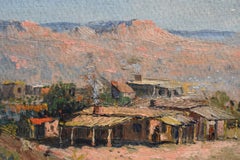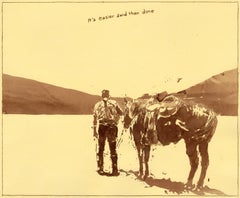Julius Stockfleth
20th Century Impressionist Landscape Paintings
Oil
1930s Impressionist Landscape Paintings
Oil
1920s Impressionist Landscape Paintings
Oil
1930s Impressionist Landscape Paintings
Oil
People Also Browsed
2010s Contemporary Figurative Drawings and Watercolors
Paper, Ink, Watercolor
Early 1900s American Impressionist Landscape Paintings
Linen, Illustration Board, Oil
1920s American Impressionist Landscape Paintings
Oil, Masonite
2010s Land Landscape Paintings
Canvas, Oil, Cotton Canvas, Mixed Media
1890s Impressionist Figurative Paintings
Oil, Panel
Early 1900s Impressionist Landscape Paintings
Oil
1960s American Impressionist Landscape Paintings
Canvas, Oil, Cardboard
1920s Impressionist Landscape Paintings
Canvas, Oil
Late 19th Century Hudson River School Landscape Paintings
Oil, Canvas
Antique 19th Century Victorian Dining Room Chairs
Elm
1930s American Impressionist Landscape Paintings
Gouache, Paper
2010s Contemporary Landscape Paintings
Canvas, Oil
1890s Impressionist Landscape Paintings
Oil, Canvas
1960s American Realist Landscape Paintings
Oil, Canvas
1920s American Impressionist Landscape Paintings
Oil, Cardboard
1930s American Impressionist Landscape Paintings
Egg Tempera, Board
Paul Schumann for sale on 1stDibs
Paul R. Schumann was a Texas impressionist seascape painter, who has been called the Gulf Coast counterpart of Winslow Homer. He was born in Reichersdorf, in the German State of Saxony, in 1876, one of four children of Albert F. Schumann and Mina Clara Zincke. Only he and his brother, Albert Otto, survived infancy. The family emigrated to the United States, in 1879 and settled in Galveston, Texas, where he lived until his death. Schumann evinced an early interest in art and received encouragement from the superintendent of the Galveston Public Schools. He studied painting with local painter, Julius Stockfleth, before turning to plein air painting. He married Carolina Adela Bergmann from Fredericksburg, Texas, in 1903 and later credited her as his inspiration. They had three children, Paul August, Clara Adela and Robert Edward. Carolina died in 1937. He painted many paintings in and around Fredericksburg, as well as New Mexico. Schumann started out as a portrait and landscape painter, but became best known for his later seascapes and harbor scenes. Writers have speculated that his preference for marine subjects was influenced by a childhood experience of falling into the mill race, at his father's sawmill or by his cross-ocean journey, at the age of three. One critic wrote that he catches with unfailing dexterity, the kinship of the sea with the sky and the land,the storm clouds, the pouty, sulky thunderheads or the washed sky, after an April shower.
Schumann built model ships, for use as models for his seascapes, which sometimes featured boats and ships, ranging from fishing vessels to three-masted schooners. During the 1910s, he traveled extensively around the United States, painting in New Mexico, Arizona, Colorado, California, Illinois and along the southeastern Atlantic Coast. His favorite site remained the Texas Gulf Coast, for its tropical colors and changeable skyscapes and he became known as a leading interpreter of typical Texas skies, as well as the deeper blues of the South Atlantic and the quiet waters of the Pacific Coast.
Schumann belonged to a number of art associations, including the Art Association of New Orleans, Galveston Art League, Society of Independent Artists, Society of Texas Artists, Southern States Art League and Texas Fine Arts Association. Schumann exhibited his work frequently and over the course of his career, won many exhibition awards, prizes and medals. His work is held in the collections of a number of museums and institutions, including the Rosenberg Library (Galveston, Texas), Fort Worth Art Museum (Texas), the Panhandle-Plains Historical Museum (Texas) and Southwest Texas State University. He died of pancreatic cancer, in 1946.
Schumann began as a realist and evolved into an impressionist, likewise, moving from brush to palette knife as his primary tool. Of his painting, The Storm, he noted that he began with a brush and later used his fingers. His heavy impasto has been likened to that of Wayne Thiebaud. His palette relied heavily on the primary colors and he worked mainly in oils, but also made watercolor, pen-and-ink and crayola studies. He frequently worked outdoors, becoming a familiar figure to local fishermen, who would sometimes shift their boats around to help out his compositions. In part, because of an impressionist technique that did not allow for a great deal of overpainting, Schumann was a prolific artist, who could turn out up to three canvases a day. He is credited with some 1500 paintings, in 25 years and was able to support his family by his painting and private teaching, even during the Depression years.
As a teacher, Schumann was said to require his students to make drawings for five years, before he would allow them to work with color. Critics have praised Schumann for the atmospheric intensity and vigor of his seascapes. One critic wrote that in American art, Mr. Schumann probably has no peer at capturing in oil dancing waters or a sailing ship on a glassy sea. The San Antonio Express admired his clearness of colors, the warm tones of the afternoon reflected sunlight and lovely transparency in the wet beach sand, all aglow from the reflections of the June skies and their billowy sunlit clouds. A French critic termed his work bold, direct and free and called Schumann himself a poet of exquisite sensibility. An American critic concluded that Schumann was doing for the Texas Gulf shores what Winslow Homer did for the Coast of Maine, arguing that if he had been painting along the New England Coast instead of the Gulf of Mexico, his marines would have been known all over the world.
A Close Look at impressionist Art
Emerging in 19th-century France, Impressionist art embraced loose brushwork and plein-air painting to respond to the movement of daily life. Although the pioneers of the Impressionist movement — Claude Monet, Edgar Degas, Paul Cézanne, Berthe Morisot, Camille Pissarro, and Pierre-Auguste Renoir — are now household names, their work was a radical break with an art scene led and shaped by academic traditions for around two centuries. These academies had oversight of a curriculum that emphasized formal drawing, painting and sculpting techniques and historical themes.
The French Impressionists were influenced by a group of artists known as the Barbizon School, who painted what they witnessed in nature. The rejection of pieces by these artists and the later Impressionists from the salons culminated in a watershed 1874 exhibition in Paris that was staged outside of the juried systems. After a work of Monet’s was derided by a critic as an unfinished “impression,” the term was taken as a celebration of their shared interest in capturing fleeting moments as subject matter, whether the shifting weather on rural landscapes or the frenzy of an urban crowd. Rather than the exacting realism of the academic tradition, Impressionist paintings, sculptures, prints and drawings represented how an artist saw a world in motion.
Many Impressionist painters were inspired by the perspectives in imported Japanese prints alongside these shifts in European painting — Édouard Manet drew on ukiyo-e woodblock prints and depicted Japanese design in his Portrait of Émile Zola, for example. American artists such as Mary Cassatt and William Merritt Chase, who studied abroad, were impacted by the work of the French artists, and by the late 19th century American Impressionism had its own distinct aesthetics with painters responding to the rapid modernization of cities through quickly created works that were vivid with color and light.
Find a collection of authentic Impressionist art on 1stDibs.
Finding the Right landscape-paintings for You
It could be argued that cave walls were the canvases for the world’s first landscape paintings, which depict and elevate natural scenery through art, but there is a richer history to consider.
The Netherlands was home to landscapes as a major theme in painting as early as the 1500s, and ink-on-silk paintings in China featured mountains and large bodies of water as far back as the third century. Greeks created vast wall paintings that depicted landscapes and grandiose garden scenes, while in the late 15th century and early 16th century, landscapes were increasingly the subject of watercolor works by the likes of Leonardo da Vinci and Fra Bartolomeo.
The popularity of religious paintings eventually declined altogether, and by the early 19th century, painters of classical landscapes took to painting out-of-doors (plein-air painting). Paintings of natural scenery were increasingly realistic but romanticized too. Into the 20th century, landscapes remained a major theme for many artists, and while the term “landscape painting” may call to mind images of lush, grassy fields and open seascapes, the genre is characterized by more variety, colors and diverse styles than you may think. Painters working in the photorealist style of landscape painting, for example, seek to create works so lifelike that you may confuse their paint for camera pixels. But if you’re shopping for art to outfit an important room, the work needs to be something with a bit of gravitas (and the right frame is important, too).
Adding a landscape painting to your home can introduce peace and serenity within the confines of your own space. (Some may think of it as an aspirational window of sorts rather than a canvas.) Abstract landscape paintings by the likes of Korean painter Seungyoon Choi or Georgia-based artist Katherine Sandoz, on the other hand, bring pops of color and movement into a room. These landscapes refuse to serve as a background. Elsewhere, Adam Straus’s technology-inspired paintings highlight how our extreme involvement with our devices has removed us from the glory of the world around us. Influenced by modern life and steeped in social commentary, Straus’s landscape paintings make us see our surroundings anew.
Whether you’re seeking works by the world’s most notable names or those authored by underground legends, find a vast collection of landscape paintings on 1stDibs.




